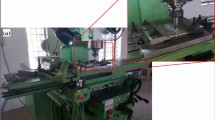Abstract
Cu-lean, high-strength 7xxx series aluminum alloys (AAs) are increasingly utilized in welded structures for vehicle light-weighting. The complex stress corrosion cracking (SCC) phenomenon in the 7xxx AA base metals has been extensively studied in the literature. However, the SCC in a welded joint is further compounded by the existence of highly inhomogeneous microstructure formed during welding. The present investigation is focused on the exacerbated SCC observed in the joints made of AA 7003-T4 (Al–Zn–Mg) plates welded with AA 5356 (Al–Mg) filler metal. It studies the contribution to SCC by a variety of factors especially the precipitates in the weld toe and the heat-affected zone in the as-welded and post-weld heat-treated conditions. The stress intensity factor experienced at the crack tip is ranked using the peak strain measured using the digital image correlation technique. Based on the testing results, a theory for the exacerbated SCC in the weld joints is established. Finally, the feasibility of two different engineering solutions to SCC in these weldments is discussed.














Similar content being viewed by others
Abbreviations
- AA:
-
Aluminum alloy
- AW:
-
As-welded
- BM:
-
Base metal
- DIC:
-
Digital image correlation
- EDM:
-
Electron discharge machining
- EDS:
-
Energy-dispersive x-ray spectroscopy
- FM:
-
Filler metal
- FOZ:
-
Fused-overlap zone
- FL:
-
Fusion line
- FSW:
-
Friction stir welding
- FZ:
-
Fusion zone
- HAZ:
-
Heat-affected zone
- IGC:
-
Intergranular corrosion
- KI :
-
Stress intensity
- KISCC :
-
Critical SCC stress intensity
- PB:
-
Paint bake
- PBTC:
-
Paint bake thermal cycle
- SCC:
-
Stress corrosion cracking
- SCC:
-
Stress corrosion cracking
- TMAZ:
-
Thermo-mechanically affected zone
- WT:
-
Weld toe
References
Knight S, Pohl K, Holroyd N, Birbilis P, Muddle B, Goswami RLS (2015) Some effects of alloy composition on stress corrosion cracking in Al–Zn–Mg–Cu alloys. Corros Sci 98:50–62. https://doi.org/10.1016/j.corsci.2015.05.016
Lin J-C, Liao H-L, Jehng W-D, Chang C-H, Lee S-L (2006) Effect of heat treatments on the tensile strength and SCC-resistance of AA7050 in an alkaline saline solution. Corros Sci 48(10):3139–3156. https://doi.org/10.1016/j.corsci.2005.11.009
Sun X, Zhang B, Lin H, Zhou Y, Sun L, Wang J, Han E-H, Ke W (2013) Correlations between stress corrosion cracking susceptibility and grain boundary microstructures for an Al–Zn–Mg alloy. Corros Sci 77:103–112. https://doi.org/10.1016/j.corsci.2013.07.032
Hatamleh O, Singh P, Garmestani H (2009) Corrosion susceptibility of peened friction stir welded 7075 aluminum alloy joints. Corros Sci 51(1):135–143. https://doi.org/10.1016/j.corsci.2008.09.031
Mousavi M, Cross C, Grong O, Hval M (1997) Controlling weld metal dilution for optimised weld performance in aluminium. Sci Technol Weld Join 2(6):275–278. https://doi.org/10.1179/stw.1997.2.6.275
S. Yang and Q. Lin, Adv. Mater. Res., Vols. 148–149, pp. 640–643, 2011
Kou S (2003) Welding metallurgy, 2nd edn. Wiley, New York
Liao C (1993) SCC behavior of an Al–3.7wt%Zn–2.5wt%Mg alloy before and after welding in 3.5% NaCl Solution. Corrosion 49(1):52–59. https://doi.org/10.5006/1.3316034
Borchers T, McAllister D, Zhang W (2015) Metall. Mater Trans A 46A:1827–1823
Borchers T, Seid A, Babu S, Shafer P, Zhang W (2015) Effect of filler metal and post-weld friction stir processing on stress corrosion cracking susceptibility of Al–Zn–Mg arc welds. Sci Technol Weld Join 20(6):460–467. https://doi.org/10.1179/1362171814Y.0000000273
M. Reboul, B. Dubost and M. Lashermes, Corros Sci, vol. 25, pp. 999–1018, 1983
Jha AK, Shiresha GN, Sreekumar K (2008) Stress corrosion cracking in alumnium alloy AFNOR 7020-T6 water tank adaptor for liquid propulsion system. Eng Fail Anal 15(6):787–795. https://doi.org/10.1016/j.engfailanal.2007.05.009
Frankel G, Xia Z (1999) Localized corrosion and stress corrosion cracking resistance of friction stir welded aluminum alloy 5454. Corrosion 55(2):139–150. https://doi.org/10.5006/1.3283974
M. Speidel, Met. Trans, vol. 6A, p. 1975
Holroyd N, Vasudevan A, Christodoulou L (1989) Stress corrosion of high-strength aluminum alloys. Treatise Mater Sci Technol 31:463–483. https://doi.org/10.1016/B978-0-12-341831-9.50021-8
Baumgartner M, Kaesche H (1988) Intercrystalline corrosion and stress corrosion cracking of AlZnMg alloys. Corrosion 44(4):231–239. https://doi.org/10.5006/1.3583931
Sprowls D, Brown R (1969) Fundamental aspects of stress corrosion cracking, R. Staehle, Ed. Houston, National Association of Corrosion Engineers
R. Braun, Mat.-wiss. u. Werkstofftech, vol. 38, no. 9, pp. 674–688, 2007
Burleigh T (1991) The postulated mechanisms for stress corrosion cracking of aluminum alloys: a review of the literature 1980–1989. Corrosion 47(2):89–97. https://doi.org/10.5006/1.3585235
G. Lu and e. al., Hydrogen enhanced local plasticity in aluminum: an ab initio study, 2002
S. Lynch, Acta Metall., vol. 36, p. 2639, 1988
Najjar D, Magnin T, Warner T (1997) Influence of critical surface defects and localized competition between anodic dissolution and hydrogen effects during stress corrosion cracking of a 7050 aluminium alloy. Mater Sci Eng A 238(2):293–302. https://doi.org/10.1016/S0921-5093(97)00369-9
Frankel G (1998) Pitting corrosion of metals. J Electrochem Soc 145(6):2186–2198. https://doi.org/10.1149/1.1838615
Zaid B, Saidi D, Benzaid A, Hadji S (2008) Corros. Sci 50:1841–1847
Nicolas M, Deschamps A (2003) Characterisation and modelling of precipitate evolution in an Al–Zn–Mg alloy during non-isothermal heat treatments. Acta Mater 51(20):6077–6094. https://doi.org/10.1016/S1359-6454(03)00429-4
Muller I, Galvele J (1976) Corros Sci 17:995–1007
J. Dabrowski and J. Kish, Corros., vol. 71, pp. 895–907, 2015
Deng Y, Peng B, Xu G, Pan Q, Ye R, Wang Y, Lu L and Z. Yin, Corros Sci, vol. 100, pp. 57–72, 2015, DOI: https://doi.org/10.1016/j.corsci.2015.06.031
Nicolas M, Deschamps A (2004) Metall Mater Trans A 35A:1437–1448
N. Holroyd and G. Scamans (2013) Metall. Mater. Trans. A, vol. 44A, pp. 1230–1253
Wu Y, Wang Y (2010) Theor. Appl Fract Mech 54(1):19–26. https://doi.org/10.1016/j.tafmec.2010.06.011
M. Baydogan, H. Cimenoglu, S. Kayali and J. Rasty (2008) Metall Mater Trans A, vol. 39A, pp. 2470–2476
Zelinski A, Chryzanowski J, Warmuzek M, Gazda A, Jezierska E (2004) Influence of retrogression and reaging on microstructure, mechanical properties and susceptibility to stress corrosion cracking of an Al–Zn–Mg alloy. Mater Corros 55(2):77–87. https://doi.org/10.1002/maco.200303710
Thakur A, Raman R, Malhotra S (2007) Hydrogen embrittlement studies of aged and retrogressed-reaged Al–Zn–Mg alloys. Mater Chem Phys 101(2–3):441–447. https://doi.org/10.1016/j.matchemphys.2006.08.004
Hwang R, Chou C (1997) The study on microstructural and mechanical properties of weld heat affected zone of 7075-T651 aluminum alloy. Scr Mater 38(2):215–221. https://doi.org/10.1016/S1359-6462(97)00472-7
Ugiansky G, Skolnick L, Steifel S (1969) Directional effects in the stress corrosion cracking of an aluminum alloy. Corrosion 25(2):77–86. https://doi.org/10.5006/0010-9312-25.2.77
T. Borchers and W. Zhang, Fused-overlap zone in aluminum arc welds: tendency of formation and effect on corrosion, in Trends in Welding Research: 10th International Conference, Tokyo, 2016
Online Materials Information Resource - MatWeb (2018) Matweb.com [Online]. Available: http://www.matweb.com. Accessed 12 Feb 2018
T. Borchers and W. Zhang (2015) Welding methods and welded joints for joining high-strength aluminum alloys. USA Patent Application No.: 62/251,427
Blaber J, Adair B, Antoniou A (2015) Ncorr: Open-Source 2D Digital Image Correlation Matlab Software. Exp Mech 55(6):1105–1122. https://doi.org/10.1007/s11340-015-0009-1
T. Borchers, A. Seid, W. Zhang, P. Shafer, S. Babu and D. Phillips, Stress corrosion cracking susceptibility of gas metal arc welded 7xxx series aluminum alloys, in Sheet Metal Welding Conference XVI, Detroit, 2014
Cooper K, Kelly R (2007) Crack tip chemistry and electrochemistry of environmental cracks in AA 7050. Corros Sci 49(6):2636–2662. https://doi.org/10.1016/j.corsci.2006.12.001
Sun X, Zhang B, Lin H, Zhou Y, Sun L, Wang J, Han E-H, Ke W (2014) Atom probe tomographic study of elemental segregation at grain boundaries for a peak-aged Al–Zn–Mg alloy. Corros Sci 79:1–4. https://doi.org/10.1016/j.corsci.2013.10.027
Galvele J (1981) Transport processes in passivity breakdown—II. Full hydrolysis of the metal ions. Corros Sci 21(8):551–579. https://doi.org/10.1016/0010-938X(81)90009-3
Acknowledgements
The present research was supported by Honda R&D Americas, Inc. through the Manufacturing and Materials Joining Innovation Center (Ma2JIC), a NSF industry/university cooperative research center (I/UCRC). STEM was performed by Rachel Seibert of the Illinois Institute of Technology using the FEI Talos F200X STEM provided by the Department of Energy, Office of Nuclear Energy, Fuel Cycle R&D Program and the Nuclear Science User Facilities. Helpful discussion with Dr. Niyanth Sridharan of Oak Ridge National Laboratory (ORNL) is acknowledged.
Author information
Authors and Affiliations
Corresponding author
Additional information
Recommended for publication by Commission IX - Behaviour of Metals Subjected to Welding
Rights and permissions
About this article
Cite this article
Borchers, T.E., Seid, A., Shafer, P. et al. Exacerbated stress corrosion cracking in arc welds of 7xxx aluminum alloys. Weld World 62, 783–792 (2018). https://doi.org/10.1007/s40194-018-0564-z
Received:
Accepted:
Published:
Issue Date:
DOI: https://doi.org/10.1007/s40194-018-0564-z




